Unit 6 Space and beyond Developing ideas 课件(共48张,内嵌视频)-高中英语外研版(2019)选择性必修第四册
文档属性
| 名称 | Unit 6 Space and beyond Developing ideas 课件(共48张,内嵌视频)-高中英语外研版(2019)选择性必修第四册 | 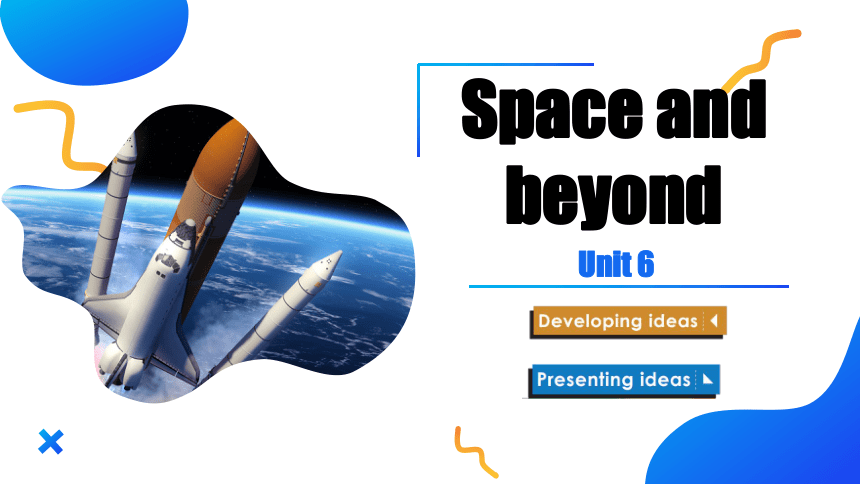 | |
| 格式 | pptx | ||
| 文件大小 | 57.4MB | ||
| 资源类型 | 教案 | ||
| 版本资源 | 外研版(2019) | ||
| 科目 | 英语 | ||
| 更新时间 | 2025-04-24 19:27:59 | ||
图片预览



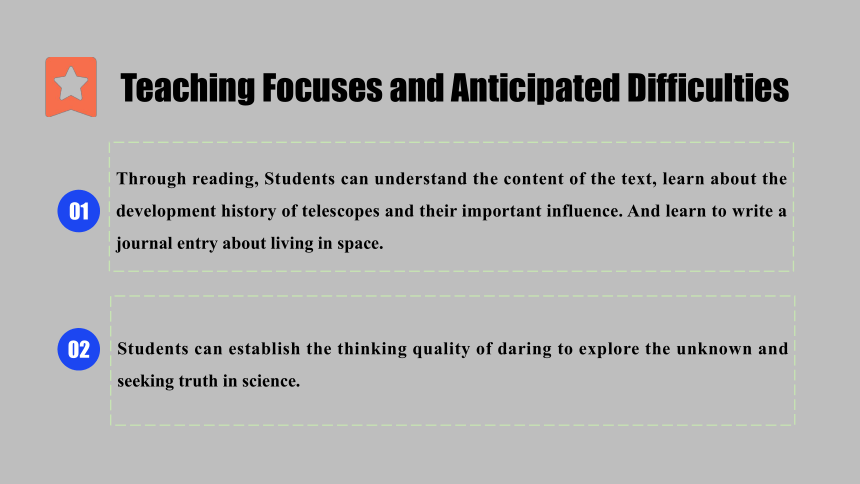
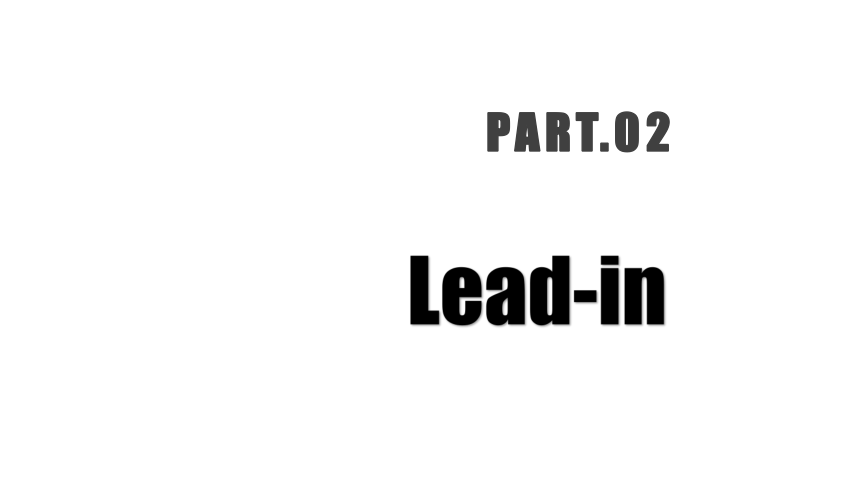
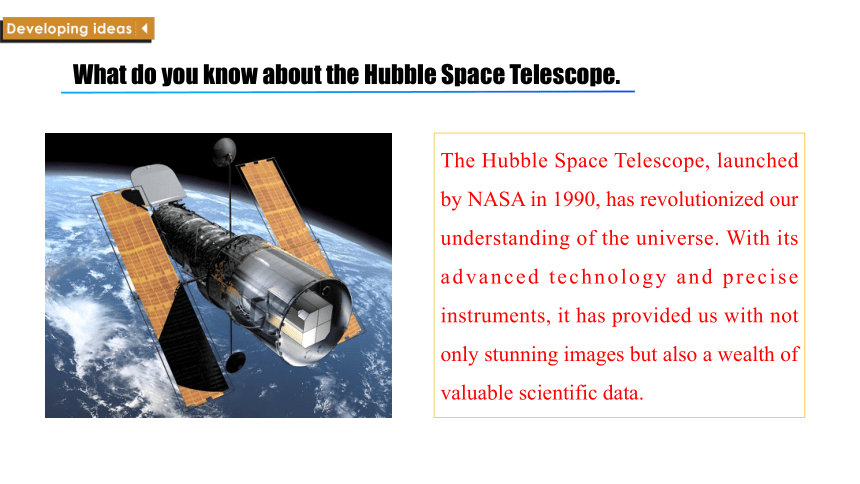
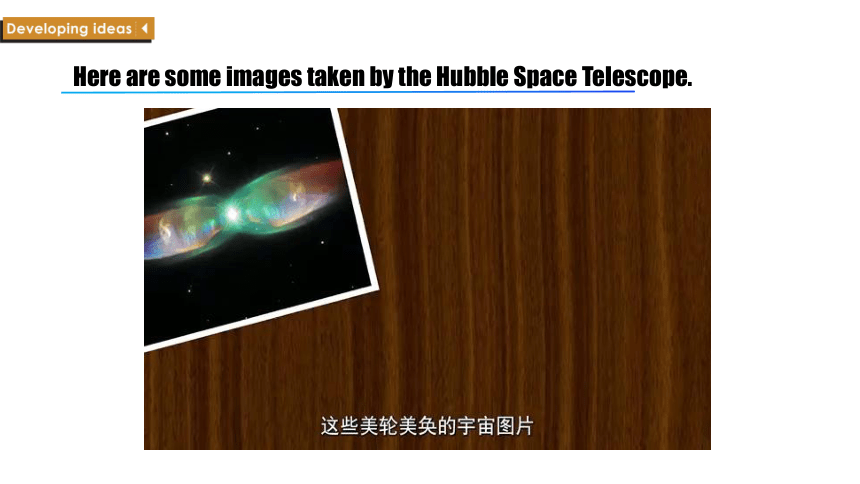

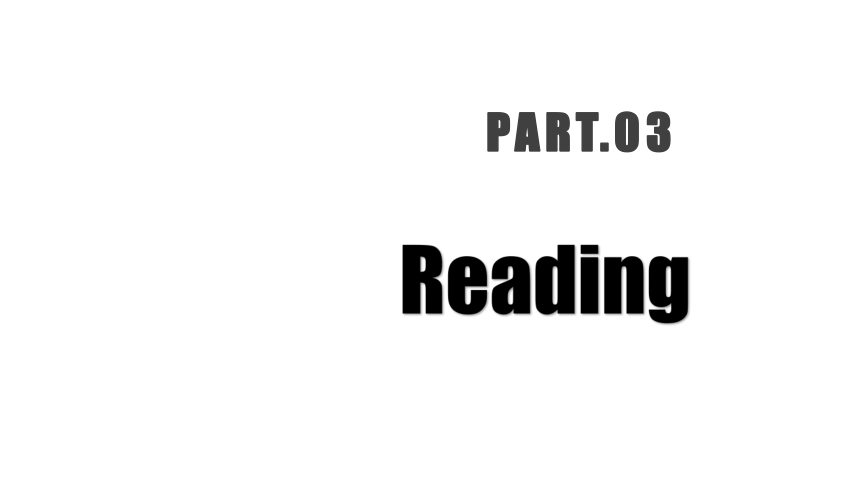
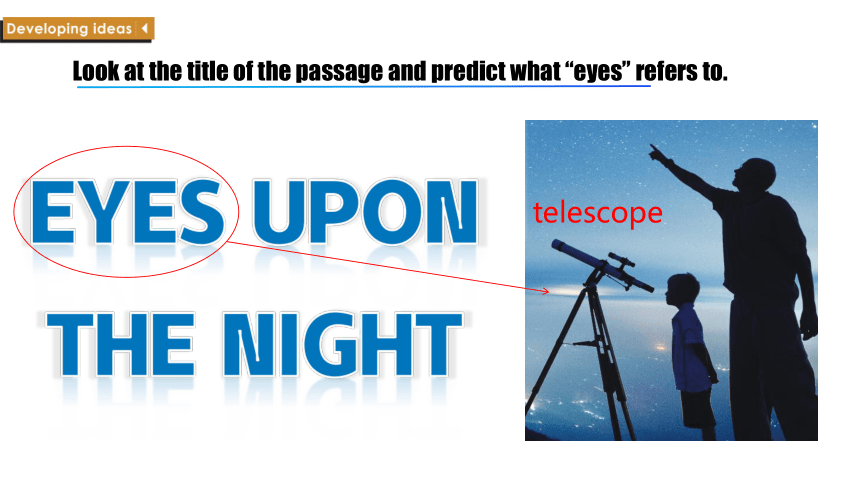

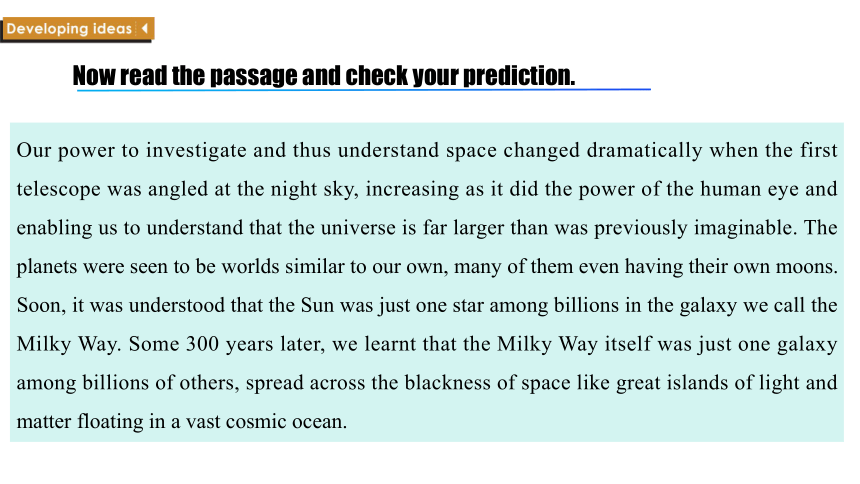
文档简介
(共48张PPT)
Unit 6
Space and beyond
PART.01
Learning Objectives
Understand the content of the text, learn about the development history of telescopes and their important influence.
01
Deepen the understanding of the theme meaning of the unit and cultivate the thinking quality of daring to explore the unknown and seeking truth in science.
03
Use the vocabulary and expressions learned in this unit, learn to write a journal entry about living in space, and describe space life.
02
Learning Objectives
Through reading, Students can understand the content of the text, learn about the development history of telescopes and their important influence. And learn to write a journal entry about living in space.
Students can establish the thinking quality of daring to explore the unknown and seeking truth in science.
01
02
Teaching Focuses and Anticipated Difficulties
PART.02
Lead-in
What do you know about the Hubble Space Telescope.
The Hubble Space Telescope, launched by NASA in 1990, has revolutionized our understanding of the universe. With its advanced technology and precise instruments, it has provided us with not only stunning images but also a wealth of valuable scientific data.
Here are some images taken by the Hubble Space Telescope.
Match the images taken by the Hubble Space Telescope to their nicknames. Do research online to find out more information about them.
01
1. The Pillars of Creation
2. The Horsehead
3. The Cat’s Eye
PART.03
Reading
Look at the title of the passage and predict what “eyes” refers to.
EYES UPON
THE NIGHT
telescope
Now read the passage and check your prediction.
The night sky has been an endless source of fascination since the start of human history. For example, the mysterious large-eyed, bronze statues of the ancient Shu Kingdom, discovered at the Chinese archaeological site at Sanxingdui, were believed to have been able to look across great distances into the stars. In reality, humans can see very little of the night sky with the naked eye. And, for a long while, people were unable to understand what they could see. Not knowing what the stars were, people in ancient times used their imaginations to create a world in the sky.
02
EYES UPON THE NIGHT
Our power to investigate and thus understand space changed dramatically when the first telescope was angled at the night sky, increasing as it did the power of the human eye and enabling us to understand that the universe is far larger than was previously imaginable. The planets were seen to be worlds similar to our own, many of them even having their own moons. Soon, it was understood that the Sun was just one star among billions in the galaxy we call the Milky Way. Some 300 years later, we learnt that the Milky Way itself was just one galaxy among billions of others, spread across the blackness of space like great islands of light and matter floating in a vast cosmic ocean.
02
Now read the passage and check your prediction.
Almost 400 years after the first Earth-based telescope was invented, the Hubble Space Telescope was launched into orbit, giving astronomers – indeed all of us – the first breathtakingly beautiful images of our universe taken from beyond Earth. Nothing in history has allowed us to see so much over such great distances, from enormous clouds of gas where stars are being born, to huge black holes, and even to new planets where we might conceivably find life. Not only that – it has also helped us to work out the age and nature of the universe, and discover the incredible fact that the universe is expanding at an ever-increasing speed.
02
Now read the passage and check your prediction.
To see even further into the universe, many countries are now engaged in building ever more advanced telescopes. Currently, China operates the world’s largest and most powerful radio telescope, the FAST telescope, completed in 2016. The 500-metre dish of the “Eye of Heaven”, as it is known, is being used in the search for dark matter, thought to be composed of subatomic particles invisible to ordinary telescopes. This vast dish also has the ability to explore regions of space billions of light years away, right at the edge of the visible universe.
The Hubble and the space telescopes constructed after it will allow us to see further and further into space. We will view stars and galaxies billions of light years away and look back at a past that was billions of years ago. Using ever-larger radio telescopes as our eyes, we will one day be able to look back to a time in the very early universe, before the existence of light. But the human quest for knowledge reaches even beyond that. So much of the universe remains unexplored that we are still close to the start of this incredible journey of discovery.
02
Now read the passage and check your prediction.
Summarise the structure.
Part 1: Para. 1
Part 2: Para. 2-4
Para. 2: the influence the first telescope had on the night sky
Para.3: the influence the Hubble Space Telescope had on the night sky
Part 3: Para. 5
Para.4: the influence the “Eye of Heaven” had on the night sky
EYES UPON THE NIGHT
ancient people’s exploration of the night sky
the exploration of the night sky
much of the universe remains unexplored.
Read the passage carefully and answer the questions.
1. According to paragraph 1, which of the following is right
A. Humans can see much of the night sky with the naked eye.
B. People in ancient times were able to understand what they saw.
C. People in ancient times used their imaginations to understand the world in the sky.
D. The large-eyed bronze statues of the ancient Wu Kingdom were believed to have been
looked across great distances into the stars.
2. What dramatically changed our power to investigate and understand space
A. The development of technology. B. The invention of the first telescope.
C. The application of the Internet. D. A better understanding of space.
Read the passage carefully and answer the questions.
3. What do we know about the Milky Way
A. It’s one of billions of stars.
B. It’s one of billions of other galaxies.
C. It’s a huge island of light.
D. It’s a world like ours.
4. Why was the Hubble Space Telescope so meaningful to the exploration of the night sky
A. Humans could understand that the Sun was just one star in the Milky Way by it.
B. We could learn that the Milky Way itself was just one galaxy among others by it.
C. It provided all of us with the first beautiful images of our universe taken from beyond Earth.
D. It had the ability to explore regions of space billions of light years away.
Read the passage carefully and answer the questions.
5. We have seen so much over great distances by using the Hubble Space Telescope except ____.
A. enormous clouds of gas where stars are being born
B. huge black holes
C. some new planets where we might find life
D. dark matter
6. Now which country operates the world’s largest and most powerful radio telescope
A. China B. America
C. Russia. D. England
Learning to learn
The order in which a series of ideas is conveyed in an essay is called “sequencing”. Time sequencing is a common method to explain how events change and develop with time. It is often used to discuss changes and development.
Think about how the author organised the passage and complete the timeline with information from the passage.
03
Thousands of years ago, people already regarded the night sky as an 1_________________________. It was believed that the huge eyes of the large-eyed bronze statues from the Chinese archaeological site at Sanxingdui were able to 2____________________________________.
endless source of fascination
look across great distances into the stars
Our power to see the sky changed dramatically when 3______________________________________. It extended 4_________________________ and caused us to realise that the universe is a far larger place than we ever imagined.
the first telescope was angled at the night sky
the power of the human eye
In 1990, the Hubble Space Telescope was launched into orbit. For the first time, people could
5______________________________________________________________________. These ranged from
6_____________________________________, and even to new planets.
see breathtakingly beautiful images of our universe taken from beyond Earth
enormous clouds of gas to huge black holes
In 2016, 7__________________was built in China. It is used in the search for dark matter, which cannot be observed by ordinary telescopes. Its 8________ has the ability to make discoveries beyond our imaginations.
the FAST telescope
vast dish
1. Why do you think people have always been interested in the stars
2. Which development in astronomy mentioned in the passage has made the greatest impression on you
Think & Share
Talk with your partner.
3. In what different ways do the two reading passages in this unit reflect the spirit of exploration
The first passage is about the Challenger disaster. Although it was a tragedy, people did not stop exploring space. This shows that people will always seek to explore, even if some lose their lives in doing so. The second passage is about the development of the telescope, and how it reflects our desire to explore the unknown. Unlike the exploration conducted by astronauts such as those in the Challenger, the exploration in the second passage was conducted by people located on Earth, at no personal risk. Nonetheless, the knowledge gained from telescopes is immense. The passages show that there are different ways of exploring the universe and of gaining knowledge.
Think & Share
Talk with your partner.
4. Have you ever used a telescope or been to planetarium Share your experience with the class.
Think & Share
Talk with your partner.
Work in groups. Give a talk about the quote.
04
The more we know, the more we feel our ignorance; the more we feel how much remains unknown.
——Humphry Davy
1. Talk about the meaning of Humphry Davy’s quote and whether you agree with it.
2. Organise your ideas by completing the notes.
Point of view:
Arguments:
Supporting examples:
Share your ideas with the class.
Now think about how well you contributed to the Group work and what you could do to improve.
PART.04
Writing
Watch the videos and think about what we can do on a spacecraft
Read the passage and answer the questions.
05
In space, even the most straightforward, everyday tasks can be quite difficult for astronauts who are spending months on board a spacecraft. In this zero gravity world, there is no up or down, and while sleeping on the ceiling might sound like fun, astronauts need to be strapped to sleeping compartments to protect themselves from injury.
Although not many people enjoy doing housework, astronauts need to find the self-discipline to keep the small interior of their spacecraft clean; even using a vacuum cleaner to stop dust from getting into the air filters. A vacuum cleaner also comes in handy for fetching items that are floating around out-of-reach!
Read the passage and answer the questions.
05
Astronauts also need to keep themselves clean. To do this, they use special soap and shampoo which do not need to be rinsed off with water. After brushing their teeth, they spit into a towel.
With no gravity to push against, astronauts’ bones and muscles can become weak. In order to stay fit, astronauts have to exercise on a regular basis.
Read the passage and answer the questions.
05
And while some food items, such as cakes and fruit can be eaten in more or less the same way that they are on Earth, water needs to be added to much of the food that is eaten in space. Nonetheless, a menu for a hungry astronaut can still be varied and balanced, often including soup, prawn sandwiches, as well as fruit yoghurt. And as salt and pepper would simply float away, astronauts are provided with these in liquid form.
Carrying out these everyday tasks effectively helps the astronauts stay healthy and focus on their work in space – after all, imagine what would happen if they caught a cold and started to sneeze!
Read the passage and answer the questions.
05
1. What is the main reason why everyday tasks are less simple in space
Everyday tasks are less simple mainly because of the zero gravity in space.
2. Why is it important for astronauts to exercise regularly
It’s important for astronauts to exercise regularly because with no gravity to push against, astronauts’ bones and muscles can become weak in space. Exercising regularly can help them stay fit.
3. What else do you know about life on a spacecraft
What does a journal entry usually include
a journal entry
What you did
Time
What you enjoyed most / least
How you felt
Imagine you have spent 24 hours on board a spacecraft. Use the notes to organise your journal entry.
06
What you did on the spacecraft:
_____________________________________________________________________________________________________________________________________________
How you felt:
_____________________________________________________________________________________________________________________________________________
What you enjoyed most/least:
_____________________________________________________________________________________________________________________________________________
Now write your journal entry. Do further research if necessary.
Sunday 12 April
I was lucky enough to be chosen as a visitor to the space station! After an exciting blast into orbit, I couldn’t wait to look through the space station windows into deep space! You can imagine my disappointment when I didn’t see many stars. The astronauts laughed and explained to me that we were still in the sunlight, so of course we couldn’t see much, because the light was too bright. Shortly after, we passed into Earth’s shadow, and I looked out of the window to see the most amazing number of stars! I felt very excited! This is the most unforgettable experience on the station. Soon after that, it was time for dinner. The thing I noticed most was not the zero gravity measures for eating, but the fact that the food didn’t have much taste. And my nose felt blocked. It turns out these things are related, because in zero gravity, your face swells up more. After that, it was time to get strapped into bed. It was a bit hard to sleep in zero gravity — my arms kept floating away, and I woke up to see them right in front of my face, instead of lying on the bed like they would on Earth. Despite even simple things being harder to do, I really enjoyed being in zero gravity, and I loved being able to float around instead of having to walk. It’s a pity my stay on the station was so short. It would have been great to stay longer and learn more about life in space!
Sample
Work in pairs. Make improvements to each other’s journal entries and share them with the class.
07
What do you know about Voyager 1
Read the news report and find out what the Voyager 1 spacecraft took into space.
01
Voyager 1 is the spacecraft most distant from Earth. It contains a record called Sounds of Earth. Which has recordings of greetings, music and sounds from Earth, as well as many photographs of our world. It is hoped that the record will be found by other civilisations on distant planets and help them learn about us.
Voyager 1 took a record called Sounds of Earth, which has recordings of greetings, music and sounds from Earth, as well as many photographs of our world.
Decide which three things you would put on a disc to be sent up on the next Voyager mission and complete the table.
02
Contents on disc Reasons for your choice
A
B
C
03
Work in groups. Share your ideas with your group and decide on a final list.
04
the structure of your presentation
useful words, expressions and structures
Prepare a short presentation. Consider the following:
05
Give your presentation to the class. Vote for the three things your class would most like to put on the disc.
PART.05
Exercise
Exercise
1. He adjusted the focus of the t__________(望远镜) to get a clearer view of the bird perched on the distant tree.
2. Regular weightlifting helped him build strong m__________(肌肉) and improve his overall fitness.
3. She a_________(斜置) the bookshelf against the wall to save space in the small room.
4. The artist used i________(看不见的) ink to write a secret message that could only be revealed with heat.
5. We had to drive to the next town to f__________(拿来) replacement parts for the broken machine.
6. His approach to solving the problem was s_______________(简单的): identify the cause and find a practical solution.
ngled
elescope
uscles
nvisible
etch
traightforward
Exercise 用所给短语的适当形式填空
1. The human body ________________ countless cells that perform different functions.
2. Her ankle began to ____________ after she twisted it while hiking.
3. The plan sounded great in theory, but _________, it was too expensive and time - consuming to implement.
4. Our company ______________ developing new technologies to improve energy efficiency.
5. After hours of discussion, they finally ______________ a solution to the problem.
in reality, work out, be composed of, be engaged in, swell up, at the edge of
is composed of
swell up
in reality
is engaged in
worked out
PART.06
Homework
Homework
Polish your journal entry.
See you next class!
Unit 6
Space and beyond
PART.01
Learning Objectives
Understand the content of the text, learn about the development history of telescopes and their important influence.
01
Deepen the understanding of the theme meaning of the unit and cultivate the thinking quality of daring to explore the unknown and seeking truth in science.
03
Use the vocabulary and expressions learned in this unit, learn to write a journal entry about living in space, and describe space life.
02
Learning Objectives
Through reading, Students can understand the content of the text, learn about the development history of telescopes and their important influence. And learn to write a journal entry about living in space.
Students can establish the thinking quality of daring to explore the unknown and seeking truth in science.
01
02
Teaching Focuses and Anticipated Difficulties
PART.02
Lead-in
What do you know about the Hubble Space Telescope.
The Hubble Space Telescope, launched by NASA in 1990, has revolutionized our understanding of the universe. With its advanced technology and precise instruments, it has provided us with not only stunning images but also a wealth of valuable scientific data.
Here are some images taken by the Hubble Space Telescope.
Match the images taken by the Hubble Space Telescope to their nicknames. Do research online to find out more information about them.
01
1. The Pillars of Creation
2. The Horsehead
3. The Cat’s Eye
PART.03
Reading
Look at the title of the passage and predict what “eyes” refers to.
EYES UPON
THE NIGHT
telescope
Now read the passage and check your prediction.
The night sky has been an endless source of fascination since the start of human history. For example, the mysterious large-eyed, bronze statues of the ancient Shu Kingdom, discovered at the Chinese archaeological site at Sanxingdui, were believed to have been able to look across great distances into the stars. In reality, humans can see very little of the night sky with the naked eye. And, for a long while, people were unable to understand what they could see. Not knowing what the stars were, people in ancient times used their imaginations to create a world in the sky.
02
EYES UPON THE NIGHT
Our power to investigate and thus understand space changed dramatically when the first telescope was angled at the night sky, increasing as it did the power of the human eye and enabling us to understand that the universe is far larger than was previously imaginable. The planets were seen to be worlds similar to our own, many of them even having their own moons. Soon, it was understood that the Sun was just one star among billions in the galaxy we call the Milky Way. Some 300 years later, we learnt that the Milky Way itself was just one galaxy among billions of others, spread across the blackness of space like great islands of light and matter floating in a vast cosmic ocean.
02
Now read the passage and check your prediction.
Almost 400 years after the first Earth-based telescope was invented, the Hubble Space Telescope was launched into orbit, giving astronomers – indeed all of us – the first breathtakingly beautiful images of our universe taken from beyond Earth. Nothing in history has allowed us to see so much over such great distances, from enormous clouds of gas where stars are being born, to huge black holes, and even to new planets where we might conceivably find life. Not only that – it has also helped us to work out the age and nature of the universe, and discover the incredible fact that the universe is expanding at an ever-increasing speed.
02
Now read the passage and check your prediction.
To see even further into the universe, many countries are now engaged in building ever more advanced telescopes. Currently, China operates the world’s largest and most powerful radio telescope, the FAST telescope, completed in 2016. The 500-metre dish of the “Eye of Heaven”, as it is known, is being used in the search for dark matter, thought to be composed of subatomic particles invisible to ordinary telescopes. This vast dish also has the ability to explore regions of space billions of light years away, right at the edge of the visible universe.
The Hubble and the space telescopes constructed after it will allow us to see further and further into space. We will view stars and galaxies billions of light years away and look back at a past that was billions of years ago. Using ever-larger radio telescopes as our eyes, we will one day be able to look back to a time in the very early universe, before the existence of light. But the human quest for knowledge reaches even beyond that. So much of the universe remains unexplored that we are still close to the start of this incredible journey of discovery.
02
Now read the passage and check your prediction.
Summarise the structure.
Part 1: Para. 1
Part 2: Para. 2-4
Para. 2: the influence the first telescope had on the night sky
Para.3: the influence the Hubble Space Telescope had on the night sky
Part 3: Para. 5
Para.4: the influence the “Eye of Heaven” had on the night sky
EYES UPON THE NIGHT
ancient people’s exploration of the night sky
the exploration of the night sky
much of the universe remains unexplored.
Read the passage carefully and answer the questions.
1. According to paragraph 1, which of the following is right
A. Humans can see much of the night sky with the naked eye.
B. People in ancient times were able to understand what they saw.
C. People in ancient times used their imaginations to understand the world in the sky.
D. The large-eyed bronze statues of the ancient Wu Kingdom were believed to have been
looked across great distances into the stars.
2. What dramatically changed our power to investigate and understand space
A. The development of technology. B. The invention of the first telescope.
C. The application of the Internet. D. A better understanding of space.
Read the passage carefully and answer the questions.
3. What do we know about the Milky Way
A. It’s one of billions of stars.
B. It’s one of billions of other galaxies.
C. It’s a huge island of light.
D. It’s a world like ours.
4. Why was the Hubble Space Telescope so meaningful to the exploration of the night sky
A. Humans could understand that the Sun was just one star in the Milky Way by it.
B. We could learn that the Milky Way itself was just one galaxy among others by it.
C. It provided all of us with the first beautiful images of our universe taken from beyond Earth.
D. It had the ability to explore regions of space billions of light years away.
Read the passage carefully and answer the questions.
5. We have seen so much over great distances by using the Hubble Space Telescope except ____.
A. enormous clouds of gas where stars are being born
B. huge black holes
C. some new planets where we might find life
D. dark matter
6. Now which country operates the world’s largest and most powerful radio telescope
A. China B. America
C. Russia. D. England
Learning to learn
The order in which a series of ideas is conveyed in an essay is called “sequencing”. Time sequencing is a common method to explain how events change and develop with time. It is often used to discuss changes and development.
Think about how the author organised the passage and complete the timeline with information from the passage.
03
Thousands of years ago, people already regarded the night sky as an 1_________________________. It was believed that the huge eyes of the large-eyed bronze statues from the Chinese archaeological site at Sanxingdui were able to 2____________________________________.
endless source of fascination
look across great distances into the stars
Our power to see the sky changed dramatically when 3______________________________________. It extended 4_________________________ and caused us to realise that the universe is a far larger place than we ever imagined.
the first telescope was angled at the night sky
the power of the human eye
In 1990, the Hubble Space Telescope was launched into orbit. For the first time, people could
5______________________________________________________________________. These ranged from
6_____________________________________, and even to new planets.
see breathtakingly beautiful images of our universe taken from beyond Earth
enormous clouds of gas to huge black holes
In 2016, 7__________________was built in China. It is used in the search for dark matter, which cannot be observed by ordinary telescopes. Its 8________ has the ability to make discoveries beyond our imaginations.
the FAST telescope
vast dish
1. Why do you think people have always been interested in the stars
2. Which development in astronomy mentioned in the passage has made the greatest impression on you
Think & Share
Talk with your partner.
3. In what different ways do the two reading passages in this unit reflect the spirit of exploration
The first passage is about the Challenger disaster. Although it was a tragedy, people did not stop exploring space. This shows that people will always seek to explore, even if some lose their lives in doing so. The second passage is about the development of the telescope, and how it reflects our desire to explore the unknown. Unlike the exploration conducted by astronauts such as those in the Challenger, the exploration in the second passage was conducted by people located on Earth, at no personal risk. Nonetheless, the knowledge gained from telescopes is immense. The passages show that there are different ways of exploring the universe and of gaining knowledge.
Think & Share
Talk with your partner.
4. Have you ever used a telescope or been to planetarium Share your experience with the class.
Think & Share
Talk with your partner.
Work in groups. Give a talk about the quote.
04
The more we know, the more we feel our ignorance; the more we feel how much remains unknown.
——Humphry Davy
1. Talk about the meaning of Humphry Davy’s quote and whether you agree with it.
2. Organise your ideas by completing the notes.
Point of view:
Arguments:
Supporting examples:
Share your ideas with the class.
Now think about how well you contributed to the Group work and what you could do to improve.
PART.04
Writing
Watch the videos and think about what we can do on a spacecraft
Read the passage and answer the questions.
05
In space, even the most straightforward, everyday tasks can be quite difficult for astronauts who are spending months on board a spacecraft. In this zero gravity world, there is no up or down, and while sleeping on the ceiling might sound like fun, astronauts need to be strapped to sleeping compartments to protect themselves from injury.
Although not many people enjoy doing housework, astronauts need to find the self-discipline to keep the small interior of their spacecraft clean; even using a vacuum cleaner to stop dust from getting into the air filters. A vacuum cleaner also comes in handy for fetching items that are floating around out-of-reach!
Read the passage and answer the questions.
05
Astronauts also need to keep themselves clean. To do this, they use special soap and shampoo which do not need to be rinsed off with water. After brushing their teeth, they spit into a towel.
With no gravity to push against, astronauts’ bones and muscles can become weak. In order to stay fit, astronauts have to exercise on a regular basis.
Read the passage and answer the questions.
05
And while some food items, such as cakes and fruit can be eaten in more or less the same way that they are on Earth, water needs to be added to much of the food that is eaten in space. Nonetheless, a menu for a hungry astronaut can still be varied and balanced, often including soup, prawn sandwiches, as well as fruit yoghurt. And as salt and pepper would simply float away, astronauts are provided with these in liquid form.
Carrying out these everyday tasks effectively helps the astronauts stay healthy and focus on their work in space – after all, imagine what would happen if they caught a cold and started to sneeze!
Read the passage and answer the questions.
05
1. What is the main reason why everyday tasks are less simple in space
Everyday tasks are less simple mainly because of the zero gravity in space.
2. Why is it important for astronauts to exercise regularly
It’s important for astronauts to exercise regularly because with no gravity to push against, astronauts’ bones and muscles can become weak in space. Exercising regularly can help them stay fit.
3. What else do you know about life on a spacecraft
What does a journal entry usually include
a journal entry
What you did
Time
What you enjoyed most / least
How you felt
Imagine you have spent 24 hours on board a spacecraft. Use the notes to organise your journal entry.
06
What you did on the spacecraft:
_____________________________________________________________________________________________________________________________________________
How you felt:
_____________________________________________________________________________________________________________________________________________
What you enjoyed most/least:
_____________________________________________________________________________________________________________________________________________
Now write your journal entry. Do further research if necessary.
Sunday 12 April
I was lucky enough to be chosen as a visitor to the space station! After an exciting blast into orbit, I couldn’t wait to look through the space station windows into deep space! You can imagine my disappointment when I didn’t see many stars. The astronauts laughed and explained to me that we were still in the sunlight, so of course we couldn’t see much, because the light was too bright. Shortly after, we passed into Earth’s shadow, and I looked out of the window to see the most amazing number of stars! I felt very excited! This is the most unforgettable experience on the station. Soon after that, it was time for dinner. The thing I noticed most was not the zero gravity measures for eating, but the fact that the food didn’t have much taste. And my nose felt blocked. It turns out these things are related, because in zero gravity, your face swells up more. After that, it was time to get strapped into bed. It was a bit hard to sleep in zero gravity — my arms kept floating away, and I woke up to see them right in front of my face, instead of lying on the bed like they would on Earth. Despite even simple things being harder to do, I really enjoyed being in zero gravity, and I loved being able to float around instead of having to walk. It’s a pity my stay on the station was so short. It would have been great to stay longer and learn more about life in space!
Sample
Work in pairs. Make improvements to each other’s journal entries and share them with the class.
07
What do you know about Voyager 1
Read the news report and find out what the Voyager 1 spacecraft took into space.
01
Voyager 1 is the spacecraft most distant from Earth. It contains a record called Sounds of Earth. Which has recordings of greetings, music and sounds from Earth, as well as many photographs of our world. It is hoped that the record will be found by other civilisations on distant planets and help them learn about us.
Voyager 1 took a record called Sounds of Earth, which has recordings of greetings, music and sounds from Earth, as well as many photographs of our world.
Decide which three things you would put on a disc to be sent up on the next Voyager mission and complete the table.
02
Contents on disc Reasons for your choice
A
B
C
03
Work in groups. Share your ideas with your group and decide on a final list.
04
the structure of your presentation
useful words, expressions and structures
Prepare a short presentation. Consider the following:
05
Give your presentation to the class. Vote for the three things your class would most like to put on the disc.
PART.05
Exercise
Exercise
1. He adjusted the focus of the t__________(望远镜) to get a clearer view of the bird perched on the distant tree.
2. Regular weightlifting helped him build strong m__________(肌肉) and improve his overall fitness.
3. She a_________(斜置) the bookshelf against the wall to save space in the small room.
4. The artist used i________(看不见的) ink to write a secret message that could only be revealed with heat.
5. We had to drive to the next town to f__________(拿来) replacement parts for the broken machine.
6. His approach to solving the problem was s_______________(简单的): identify the cause and find a practical solution.
ngled
elescope
uscles
nvisible
etch
traightforward
Exercise 用所给短语的适当形式填空
1. The human body ________________ countless cells that perform different functions.
2. Her ankle began to ____________ after she twisted it while hiking.
3. The plan sounded great in theory, but _________, it was too expensive and time - consuming to implement.
4. Our company ______________ developing new technologies to improve energy efficiency.
5. After hours of discussion, they finally ______________ a solution to the problem.
in reality, work out, be composed of, be engaged in, swell up, at the edge of
is composed of
swell up
in reality
is engaged in
worked out
PART.06
Homework
Homework
Polish your journal entry.
See you next class!
